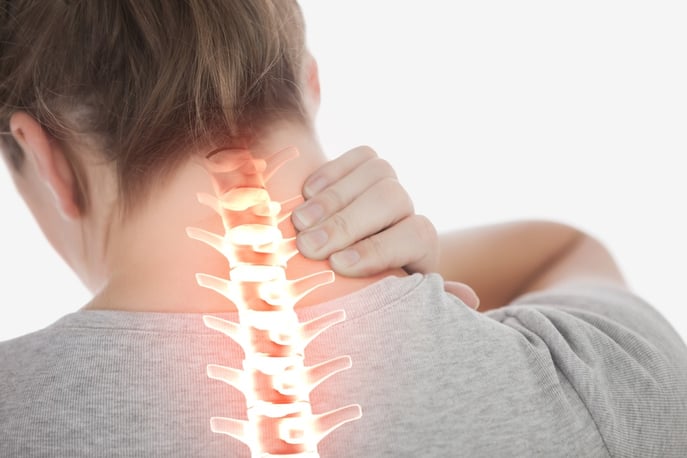
The old saying “love and marriage go together like a horse and carriage,” also applies to migraine headaches and neck pain, although with a lot less enjoyment!
Given that the head and neck are so closely connected, it makes sense something affecting one so strongly is likely to affect the other. What’s the connection between neck pain and migraine, and how do you know whether you have a migraine or a neck headache?
By the Numbers
Various studies show up to 87 percent of migraine patients experience tightness, stiffness or pain in their necks, either before or during an attack. In some surveys, neck pain is listed as being three times more common than migraine aura or vomiting. Three-quarters of patients experienced this type of pain with a migraine, with 60 percent saying it began before the headache, making it a precursor to the attack.
Symptoms
A 2010 study showed neck pain was an even more common symptom than nausea. Some of the signs of migraine related to neck pain include:
- tightness and stiffness in the neck
- a reduced range of neck movement
- headaches that worsen when you apply pressure to certain parts of the neck
- pain located on one side of the head only
- pain that spreads from the back of the head and neck up to the front
- headache pain behind the eyes
Any of these types of pain might or might not be linked to neck pain. Various structures in the upper neck and back of the head are pain-generating, such as the cervical spine lining, the ligaments, roots of the cervical nerves and the arteries that pass through cervical vertebrae.
Causes of Neck Pain and Migraine
Tightness and pain in the muscles and joints of your neck are usually indications of stress, either physical or emotional, poor posture or another medical condition. Some migraines start in the neck or the base of your skull, and patients often experience occipital neuralgia, which is a severe, throbbing pain in the upper neck area or behind the ears, usually on one side of the head.
Posture problems can be related to the way you stand, walk, hold your shoulders or the type of work you do and the location. People who work at a desk for long hours could be particularly likely to develop posture issues affecting their neck. Posture is recognized as being a primary cause of tension headaches, but it sometimes gets insufficient attention from the migraine community.
Age-related wear and tear affecting the joints in your neck could also cause neck pain, resulting in stimulation of the nerves in the neck that extend into your head. Any dysfunction of the neck joints could cause pain that travels upwards into the head, resulting in migraine in patients prone to attacks. The joints most commonly involved are those in your upper neck, which are the Atlanto-occipital joint, Atlanto-axial joint and the C2/C3 cervical spine joints. Pain in these areas can be either a cause of your migraine, or the result of it.
Getting a Diagnosis
To determine whether your neck pain and migraines are related, it’s important to document how you feel on a daily basis.
Record when your neck pain begins, and where it seems to be located. Make note of any other areas of the body where you feel stiffness or tenderness. Track whether these last for the same time as the neck pain, and whether a migraine attacks within a few hours or days of the onset of neck pain.
Based on these records, your doctor might order an X-ray, MRI or blood tests to help diagnose the issue.
Treatment Options
If your migraine attacks are connected to neck problems, it’s essential for finding relief that you identify the cause and treat the underlying condition at the same time.
Some medical conditions your migraine doctor may test for include:
- Neck injuries, such as a ruptured disc, spinal fracture, cancer or infection
- Bone disorders such as osteoporosis, arthritis, worn joints or spurs affecting the bones of the neck or spine
- Spinal stenosis, which is narrowing of the spinal canal
- Muscle strain, compressed nerves, whiplash from poor posture or an injury
- Autoimmune conditions such as rheumatoid arthritis or fibromyalgia
Once you get a diagnosis, your migraine doctor will work with the specialist for your condition, to resolve or minimize the impact of the neck pain on your headaches. Treatments could include chiropractic care, physiotherapy, anti-inflammatories and pain medication, neck surgery or remedies specific to the underlying cause. Neck joint injuries can be treated with injections containing a local anesthetic plus a steroid to reduce the frequency of migraines, or massage therapy directed at the suboccipital muscles of the neck.
Migraine patients often experience multiple related medical conditions, and often finding relief for one will help you get some respite from the other.


